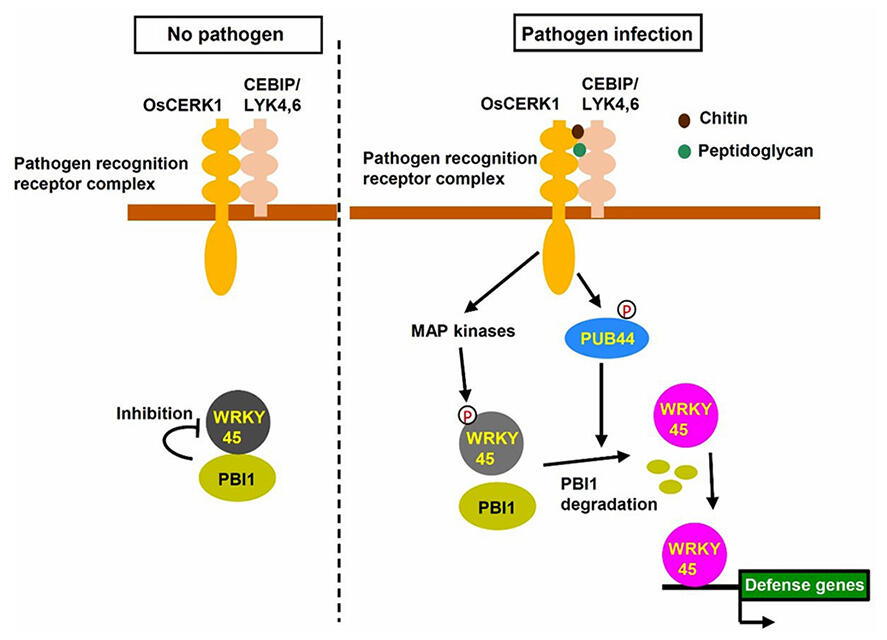A research group comprised of Professor Tsutomu Kawasaki, graduate student Kota Ichimaru (at the time of research), and Lecturer Koji Yamaguchi of the Agricultural Technology and Innovation Research Institute, Graduate School of Agriculture, Kindai University, has identified the mechanism by which rice plants adjust the energy balance between growth and their immune systems in collaboration with the Institute for Protein Research, Osaka University, Yokohama National University, Iwate Biotechnology Research Center, and the National Agriculture and Food Research Organization (NARO). The group identified PBI1, a protein important in inducing an immune response in rice plants, learning that it inhibits the activation of immunity by bonding with WRKY45, a key factor in immunity activation. Then, when an infection is detected, PBI1 is broken down to activate the immune system. Accordingly, the group learned that enhancing the expression of both WRKY45 and PBI1 to a high degree may strengthen the plant's disease resistance. This finding, which was published in the May 16 issue of the international scientific journal Nature Communications, is expected to lead to the breeding of a wide variety of disease-resistant plants.

Provided by Kindai University
Losses to agricultural yield from disease exceeds nearly 15%, making the development of next generation disease-resistant technology an urgent issue for stable food production. Plants have built-in defense systems for inducing immunity against pathogens. Specifically, defensive responses are triggered by the detection of proteins and other substances derived from pathogens, by receptors on the surfaces of cells. WRKY45 is a transcription factor discovered in 2006 by NARO that is known to be a key factor in the immune systems of rice plants, and rice plants in which the gene has been excessively expressed exhibit strong resistance to a variety of diseases such as rice blast. Since the discovery, research around the world has shown that this gene controls the expression of numerous genes related to immunity.
Previously, in the course of researching disease-resistance in rice, the research group at Kindai University had discovered PUB44, an enzyme called ubiquitin ligase that regulates rice immunity. The research group then went on to discover PBI1 while searching for proteins that interact with PUB44. The group learned that in the absence of pathogens, PBI1 binds directly with WRKY45 to control its activity. Then, through structural analysis carried out in cooperation with the Faculty of Engineering, Yokohama National University, and the Institute for Protein Research, Osaka University, they learned that PBI1 is comprised of a four-helix bundle. They also learned that the protein is ubiquitinated by PUB44 and broken down by the proteasome.
Plants must make a trade-off between growth and immunity. Overactivation of the immune system requires a great deal of energy, so it is important to only activate that system when a pathogen is identified. It has been found that rice plant growth is slowed when PBI1 is removed, causing the plants to become reduced in size.
In the absence of pathogens, PBI1 binds to the key immune factor WRKY and suppresses immunity activation by inhibiting this behavior. But the group found that when a pathogen was recognized, PBI1 was broken down via ubiquitin ligase PUB44, activating the immune system. It is highly likely that other plants share a similar system, so the finding is expected to be useful in breeding a wide variety of plants with strengthened disease-resistance.
According to Professor Kawasaki, "Moving forward, we hope to clarify what exactly is happening during the process by which receptors detect pathogens and activate PUB44, while also examining the possible applications for PBI1 and WRKY45. Currently, we have learned that there is a phosphate group attached to PUB44, as well as which amino acid is being phosphorylated. We intend to further clarify the details of this mechanism."
This article has been translated by JST with permission from The Science News Ltd.(https://sci-news.co.jp/). Unauthorized reproduction of the article and photographs is prohibited.




